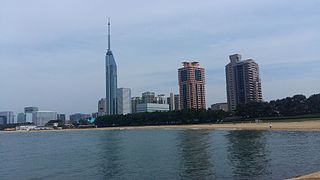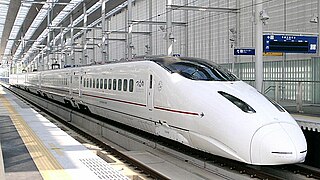
Fukuoka is the sixth-largest city in Japan, the second-largest port city after Yokohama, and the capital city of Fukuoka Prefecture, Japan. The city is built along the shores of Hakata Bay, and has been a center of international commerce since ancient times. The area has long been considered the gateway to the country, as it is the nearest point among Japan's main islands to the Asian mainland. Although humans occupied the area since the Jomon period, some of the earliest settlers of the Yayoi period arrived in the Fukuoka area. The city rose to prominence during the Yamato period. Because of the cross-cultural exposure, and the relatively great distance from the social and political centers of Kyoto, Osaka, and later, Edo (Tokyo), Fukuoka gained a distinctive local culture and dialect that has persisted to the present.

Fukuoka Prefecture is a prefecture of Japan located on the island of Kyūshū. Fukuoka Prefecture has a population of 5,109,323 and has a geographic area of 4,986 km2. Fukuoka Prefecture borders Saga Prefecture to the southwest, Kumamoto Prefecture to the south, and Ōita Prefecture to the southeast.

Hakata-ku (博多区) is a ward of the city of Fukuoka in Fukuoka Prefecture, Japan.

Fukuoka Airport, formerly known as Itazuke Air Base, is an international and domestic airport located 1.6 NM east of Hakata Station in Hakata-ku, Fukuoka, Japan.

Ōnojō is an area located in Fukuoka Prefecture, Japan. Its name is made up of the kanji for 'big', 'field', and 'castle'. It is mostly a southern suburb of the city of Fukuoka, and has a border to the northwest with the Hakata-ku area of the city. It also shares borders with Dazaifu and Kasuga, Umi, Chikushino, Nakagawa and Shime. The border with Umi is marked by the summit of Otoganayama at 268 metres above sea level, a wide expanse of deciduous and bamboo forest, uninhabited except by the occasional snake. The Mikasa River flows through Ōnojō on its way to Hakata bay, with some of its tributaries such as Cow Neck River originating in the mountains in the south. Ducks, turtles, koi, egrets, herons and Japanese wagtails can be seen in or around the river, depending on the season.

Hakata Station is a major railway station in Hakata-ku, Fukuoka, Japan. It is the largest and busiest station in Kyushu, and is a gateway to other cities in Kyushu for travellers from Honshu. The San'yō Shinkansen from Osaka ends at this station.

The Kyushu Shinkansen is a line of the Japanese Shinkansen high-speed rail network. It is an extension of the San'yō Shinkansen from Honshu, connecting the cities of Fukuoka in the North and Kagoshima in the South of Japan's Kyushu island. It runs parallel to the existing Kagoshima Main Line and is operated by the Kyushu Rail Company.

The Fukuoka City Subway serves Fukuoka, Japan. It consists of three subway lines, the Kūkō, or Airport Line, the Hakozaki Line and the Nanakuma Line).

The Chikuhi Line is a railway line in Kyushu, Japan, connecting Meinohama Station in Fukuoka, Fukuoka to Karatsu Station in Karatsu, Saga, and from Yamamoto Station in Karatsu to Imari Station in Imari, Saga. Trains from Karatsu to Imari use the Karatsu Line to Yamamoto.

Meinohama Station is a railway station in Nishi-ku, Fukuoka, Fukuoka Prefecture, Japan. It is jointly operated by JR Kyushu and the Fukuoka City Transportation Bureau. The station symbol of the subway station is a yacht in yellow, symbolising nearby Odo yacht harbour(ja).
Shin-Tamana Station is a railway station on the Kyushu Shinkansen in Tamana, Kumamoto, Japan, operated by the Kyushu Railway Company. The station opened on March 12, 2011.
The following is a timeline of the history of the city of Seoul, South Korea.
The following is a timeline of the history of the city of Kyoto, Kyoto Prefecture, Honshu island, Japan.
The following is a timeline of the history of the city of Osaka, Japan.
The following is a timeline of the history of the city of Yokohama, Japan.
The following is a timeline of the history of the city of Nagasaki, Japan.
The following is a timeline of the history of the city of Kobe, Japan.
The following is a timeline of the history of the city of Nagoya, Japan.
The following is a timeline of the history of the city of Hiroshima, Japan.
The following is a timeline of the history of Tokyo, Japan.










